Arduino
Arduino (/ɑːrˈdwiːnoʊ/) is an open-source hardware and software company, project and user community that designs and manufactures single-board microcontrollers and microcontroller kits for building digital devices. Its hardware products are licensed under a CC-BY-SA license, while software is licensed under the GNU Lesser General Public License (LGPL) or the GNU General Public License (GPL),[1] permitting the manufacture of Arduino boards and software distribution by anyone. Arduino boards are available commercially from the official website or through authorized distributors.
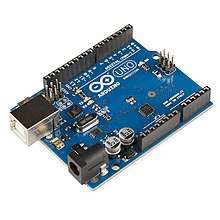 Arduino Uno SMD R3 | |
| Developer | arduino.cc |
|---|---|
| Manufacturer | Arduino |
| Type | Single-board microcontroller |
| Operating system | None |
| CPU | Atmel AVR (8-bit), ARM Cortex-M0+ (32-bit), ARM Cortex-M3 (32-bit), Intel Quark (x86) (32-bit) |
| Memory | SRAM |
| Storage | Flash, EEPROM |
| Website | www |
Arduino board designs use a variety of microprocessors and controllers. The boards are equipped with sets of digital and analog input/output (I/O) pins that may be interfaced to various expansion boards ('shields') or breadboards (for prototyping) and other circuits. The boards feature serial communications interfaces, including Universal Serial Bus (USB) on some models, which are also used for loading programs from personal computers. The microcontrollers can be programmed using the C and C++ programming languages, using a standard API which is also known as the "Arduino language". In addition to using traditional compiler toolchains, the Arduino project provides an integrated development environment (IDE) and a command line tool (arduino-cli) developed in Go.
The Arduino project started in 2005 as a tool for students at the Interaction Design Institute Ivrea in Ivrea, Italy,[2] aiming to provide a low-cost and easy way for novices and professionals to create devices that interact with their environment using sensors and actuators. Common examples of such devices intended for beginner hobbyists include simple robots, thermostats and motion detectors.
The name Arduino comes from a bar in Ivrea, Italy, where some of the founders of the project used to meet. The bar was named after Arduin of Ivrea, who was the margrave of the March of Ivrea and King of Italy from 1002 to 1014.[3]
History
The Arduino project was started at the Interaction Design Institute Ivrea (IDII) in Ivrea, Italy.[2] At that time, the students used a BASIC Stamp microcontroller at a cost of $50, a considerable expense for many students. In 2003 Hernando Barragán created the development platform Wiring as a Master's thesis project at IDII, under the supervision of Massimo Banzi and Casey Reas. Casey Reas is known for co-creating, with Ben Fry, the Processing development platform. The project goal was to create simple, low cost tools for creating digital projects by non-engineers. The Wiring platform consisted of a printed circuit board (PCB) with an ATmega168 microcontroller, an IDE based on Processing and library functions to easily program the microcontroller.[4] In 2005, Massimo Banzi, with David Mellis, another IDII student, and David Cuartielles, extended Wiring by adding support for the cheaper ATmega8 microcontroller. The new project, forked from Wiring, was called Arduino.[4]
The initial Arduino core team consisted of Massimo Banzi, David Cuartielles, Tom Igoe, Gianluca Martino, and David Mellis[2].
Following the completion of the platform, lighter and less expensive versions were distributed in the open-source community. It was estimated in mid-2011 that over 300,000 official Arduinos had been commercially produced,[5] and in 2013 that 700,000 official boards were in users' hands.[6]
Trademark dispute
In early 2008, the five co-founders of the Arduino project created a company, Arduino LLC,[7] to hold the trademarks associated with Arduino. The manufacture and sale of the boards was to be done by external companies, and Arduino LLC would get a royalty from them. The founding bylaws of Arduino LLC specified that each of the five founders transfer ownership of the Arduino brand to the newly formed company.
At the end of 2008, Gianluca Martino's company, Smart Projects, registered the Arduino trademark in Italy and kept this a secret from the other co-founders for about two years. This was revealed when the Arduino company tried to register the trademark in other areas of the world (they originally registered only in the US), and discovered that it was already registered in Italy. Negotiations with Gianluca and his firm to bring the trademark under control of the original Arduino company failed. In 2014, Smart Projects began refusing to pay royalties. They then appointed a new CEO, Federico Musto, who renamed the company Arduino SRL and created the website arduino.org, copying the graphics and layout of the original arduino.cc. This resulted in a rift in the Arduino development team.[8][9][10]
In January 2015, Arduino LLC filed a lawsuit against Arduino SRL.[11]
In May 2015, Arduino LLC created the worldwide trademark Genuino, used as brand name outside the United States.[12]
At the World Maker Faire in New York on 1 October 2016, Arduino LLC co-founder and CEO Massimo Banzi and Arduino SRL CEO Federico Musto announced the merger of the two companies.[13] Around that same time, Massimo Banzi announced that in addition to the company a new Arduino Foundation would be launched as "a new beginning for Arduino.", but this decision was withdrawn later[14].[15]
In April 2017, Wired reported that Musto had "fabricated his academic record.... On his company's website, personal LinkedIn accounts, and even on Italian business documents, Musto was until recently listed as holding a PhD from the Massachusetts Institute of Technology. In some cases, his biography also claimed an MBA from New York University." Wired reported that neither university had any record of Musto's attendance, and Musto later admitted in an interview with Wired that he had never earned those degrees.[16] The controversy surrounding Musto continued when, in July 2017, he reportedly pulled many Open source licenses, schematics, and code from the Arduino website, prompting scrutiny and outcry.[17]
By 2017 Arduino AG owned many Arduino trademarks. In July 2017 BCMI, founded by Massimo Banzi, David Cuartielles, David Mellis and Tom Igoe, acquired Arduino AG and all the Arduino trademarks. Fabio Violante is the new CEO replacing Federico Musto, who no longer works for Arduino AG.[18][19]
Post-dispute
In October 2017, Arduino announced its partnership with ARM Holdings (ARM). The announcement said, in part, "ARM recognized independence as a core value of Arduino ... without any lock-in with the ARM architecture.” Arduino intends to continue to work with all technology vendors and architectures.[20]
Under Violante's guidance, the company started growing again and releasing new designs. The Genuino trademark was dismissed and all products were branded again with the Arduino name. As of February 2020, the Arduino community included about 30 million active users based on the IDE downloads[21].
In August 2018, Arduino announced its new open source command line tool (arduino-cli), which can be used as a replacement of the IDE to program the boards from a shell[22].
In February 2019, Arduino announced its IoT Cloud service as an extension of the Create online environment.[23]
Hardware
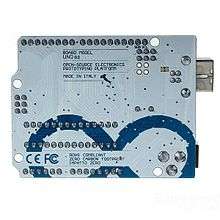
Arduino is open-source hardware. The hardware reference designs are distributed under a Creative Commons Attribution Share-Alike 2.5 license and are available on the Arduino website. Layout and production files for some versions of the hardware are also available.
Although the hardware and software designs are freely available under copyleft licenses, the developers have requested the name Arduino to be exclusive to the official product and not be used for derived works without permission. The official policy document on use of the Arduino name emphasizes that the project is open to incorporating work by others into the official product.[24] Several Arduino-compatible products commercially released have avoided the project name by using various names ending in -duino.[25]
Most Arduino boards consist of an Atmel 8-bit AVR microcontroller (ATmega8,[27] ATmega168, ATmega328, ATmega1280, or ATmega2560) with varying amounts of flash memory, pins, and features.[28] The 32-bit Arduino Due, based on the Atmel SAM3X8E was introduced in 2012.[29] The boards use single or double-row pins or female headers that facilitate connections for programming and incorporation into other circuits. These may connect with add-on modules termed shields. Multiple and possibly stacked shields may be individually addressable via an I²C serial bus. Most boards include a 5 V linear regulator and a 16 MHz crystal oscillator or ceramic resonator. Some designs, such as the LilyPad, run at 8 MHz and dispense with the onboard voltage regulator due to specific form-factor restrictions.
Arduino microcontrollers are pre-programmed with a boot loader that simplifies uploading of programs to the on-chip flash memory. The default bootloader of the Arduino Uno is the Optiboot bootloader.[30] Boards are loaded with program code via a serial connection to another computer. Some serial Arduino boards contain a level shifter circuit to convert between RS-232 logic levels and transistor–transistor logic (TTL) level signals. Current Arduino boards are programmed via Universal Serial Bus (USB), implemented using USB-to-serial adapter chips such as the FTDI FT232. Some boards, such as later-model Uno boards, substitute the FTDI chip with a separate AVR chip containing USB-to-serial firmware, which is reprogrammable via its own ICSP header. Other variants, such as the Arduino Mini and the unofficial Boarduino, use a detachable USB-to-serial adapter board or cable, Bluetooth or other methods. When used with traditional microcontroller tools, instead of the Arduino IDE, standard AVR in-system programming (ISP) programming is used.
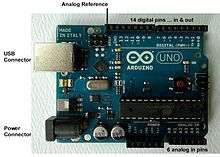
The Arduino board exposes most of the microcontroller's I/O pins for use by other circuits. The Diecimila,[lower-alpha 1] Duemilanove,[lower-alpha 2] and current Uno[lower-alpha 3] provide 14 digital I/O pins, six of which can produce pulse-width modulated signals, and six analog inputs, which can also be used as six digital I/O pins. These pins are on the top of the board, via female 0.1-inch (2.54 mm) headers. Several plug-in application shields are also commercially available. The Arduino Nano, and Arduino-compatible Bare Bones Board[31] and Boarduino[32] boards may provide male header pins on the underside of the board that can plug into solderless breadboards.
Many Arduino-compatible and Arduino-derived boards exist. Some are functionally equivalent to an Arduino and can be used interchangeably. Many enhance the basic Arduino by adding output drivers, often for use in school-level education, to simplify making buggies and small robots. Others are electrically equivalent, but change the form factor, sometimes retaining compatibility with shields, sometimes not. Some variants use different processors, of varying compatibility.
Official boards
The original Arduino hardware was manufactured by the Italian company Smart Projects.[33] Some Arduino-branded boards have been designed by the American companies SparkFun Electronics and Adafruit Industries.[34] As of 2016, 17 versions of the Arduino hardware have been commercially produced.
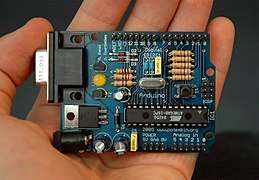 Arduino RS232[35]
Arduino RS232[35]
(male pins)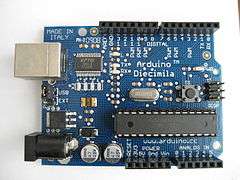 Arduino Diecimila[36]
Arduino Diecimila[36]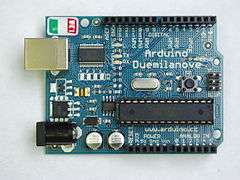 Arduino Duemilanove[37]
Arduino Duemilanove[37]
(rev 2009b)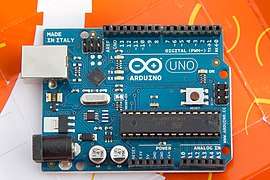

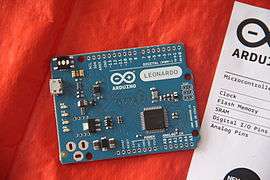 Arduino Leonardo[41]
Arduino Leonardo[41]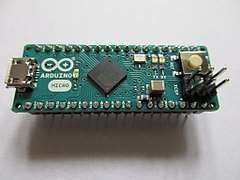 Arduino micro(AtMega 32U4)
Arduino micro(AtMega 32U4)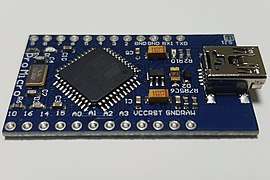 Arduino pro micro (AtMega32U4)
Arduino pro micro (AtMega32U4) Arduino Pro[42]
Arduino Pro[42]
(No USB)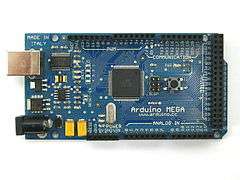 Arduino Mega[43]
Arduino Mega[43]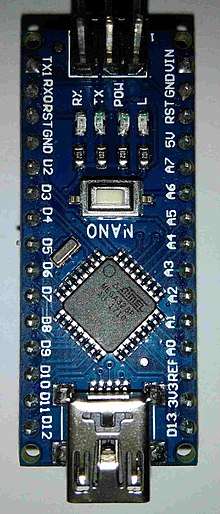 Arduino Nano[44]
Arduino Nano[44]
(DIP-30 footprint)- Arduino LilyPad 00[45]
(rev 2007) (No USB) 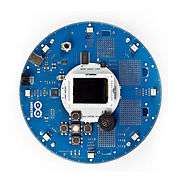 Arduino Robot[46]
Arduino Robot[46]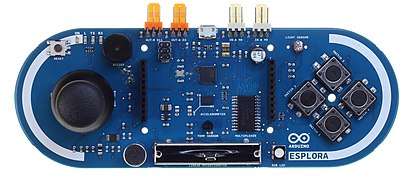 Arduino Esplora[47]
Arduino Esplora[47]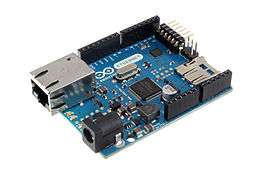 Arduino Ethernet[48]
Arduino Ethernet[48]
(AVR + W5100)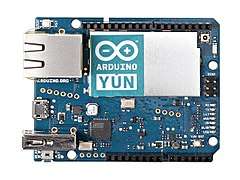 Arduino Yún[49]
Arduino Yún[49]
(AVR + AR9331)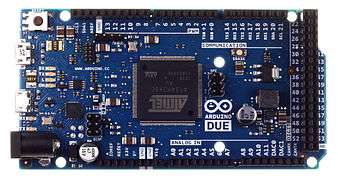 Arduino Due[50]
Arduino Due[50]
(ARM Cortex-M3 core)
Shields
Arduino and Arduino-compatible boards use printed circuit expansion boards called shields, which plug into the normally supplied Arduino pin headers.[51] Shields can provide motor controls for 3D printing and other applications, GNSS (satellite navigation), Ethernet, liquid crystal display (LCD), or breadboarding (prototyping). Several shields can also be made do it yourself (DIY).[52][53][54]
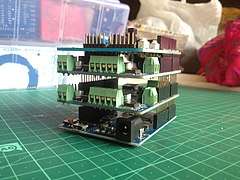 Some shields offer stacking headers which allows multiple shields to be stacked on top of an Arduino board. Here, a prototyping shield is stacked on two Adafruit motor shield V2s.
Some shields offer stacking headers which allows multiple shields to be stacked on top of an Arduino board. Here, a prototyping shield is stacked on two Adafruit motor shield V2s.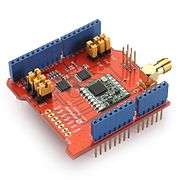 Dragino Lora Shield allows the user to send data and reach extremely long ranges at low data-rates.
Dragino Lora Shield allows the user to send data and reach extremely long ranges at low data-rates.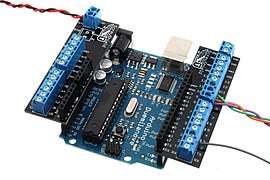 Screw-terminal breakout shield in a wing-type format, allowing bare-end wires to be connected to the board without requiring any specialized pins.
Screw-terminal breakout shield in a wing-type format, allowing bare-end wires to be connected to the board without requiring any specialized pins.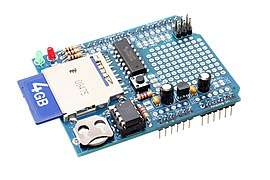 Adafruit Datalogging Shield with a Secure Digital (SD) card slot and real-time clock (RTC) chip along with some space for adding components and modules for customization.
Adafruit Datalogging Shield with a Secure Digital (SD) card slot and real-time clock (RTC) chip along with some space for adding components and modules for customization. Adafruit Motor Shield with screw terminals for connection to motors. Officially discontinued, this shield may still be available through unofficial channels.
Adafruit Motor Shield with screw terminals for connection to motors. Officially discontinued, this shield may still be available through unofficial channels.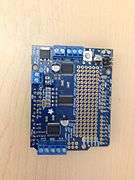
- A USB host shield which allows an Arduino board to communicate with a USB device such as a keyboard or a mouse.
Software
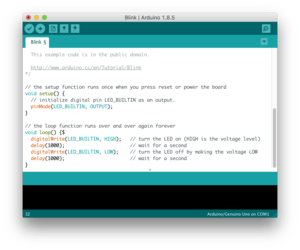 Screenshot of Arduino IDE showing Blink program | |
| Developer(s) | Arduino Software |
|---|---|
| Stable release | 1.8.13
/ 16 June 2020[55] |
| Repository | |
| Written in | Java, C, C++ |
| Operating system | Windows, macOS, Linux |
| Platform | IA-32, x86-64, ARM |
| Type | Integrated development environment |
| License | LGPL or GPL license |
| Website | www |
A program for Arduino hardware may be written in any programming language with compilers that produce binary machine code for the target processor. Atmel provides a development environment for their 8-bit AVR and 32-bit ARM Cortex-M based microcontrollers: AVR Studio (older) and Atmel Studio (newer).[56][57][58]
IDE
The Arduino integrated development environment (IDE) is a cross-platform application (for Windows, macOS, and Linux) that is written in the programming language Java. It originated from the IDE for the languages Processing and Wiring. It includes a code editor with features such as text cutting and pasting, searching and replacing text, automatic indenting, brace matching, and syntax highlighting, and provides simple one-click mechanisms to compile and upload programs to an Arduino board. It also contains a message area, a text console, a toolbar with buttons for common functions and a hierarchy of operation menus. The source code for the IDE is released under the GNU General Public License, version 2.[59]
The Arduino IDE supports the languages C and C++ using special rules of code structuring. The Arduino IDE supplies a software library from the Wiring project, which provides many common input and output procedures. User-written code only requires two basic functions, for starting the sketch and the main program loop, that are compiled and linked with a program stub main() into an executable cyclic executive program with the GNU toolchain, also included with the IDE distribution. The Arduino IDE employs the program avrdude to convert the executable code into a text file in hexadecimal encoding that is loaded into the Arduino board by a loader program in the board's firmware.
Pro IDE
On October 18, 2019, Arduino Pro IDE (alpha preview) was released. The system still uses Arduino CLI (Command Line Interface), but improvements include a more professional development environment, autocompletion support, and Git integration.[60] The application frontend is based on the Eclipse Theia Open Source IDE. The main features available in the alpha release are:[61]
- Modern, fully featured development environment
- Dual Mode, Classic Mode (identical to the Classic Arduino IDE) and Pro Mode (File System view)
- New Board Manager
- New Library Manager
- Board List
- Basic Auto-Completion (Arm targets only)
- Git Integration
- Serial Monitor
- Dark Mode
Sketch
A sketch is a program written with the Arduino IDE.[62] Sketches are saved on the development computer as text files with the file extension .ino. Arduino Software (IDE) pre-1.0 saved sketches with the extension .pde.
A minimal Arduino C/C++ program consists of only two functions:[63]
setup(): This function is called once when a sketch starts after power-up or reset. It is used to initialize variables, input and output pin modes, and other libraries needed in the sketch. It is analogous to the functionmain().[64]loop(): Aftersetup()function exits (ends), theloop()function is executed repeatedly in the main program. It controls the board until the board is powered off or is reset. It is analogous to the functionwhile(1).[65]
- Blink example
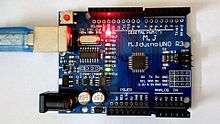
Most Arduino boards contain a light-emitting diode (LED) and a current limiting resistor connected between pin 13 and ground, which is a convenient feature for many tests and program functions.[66] A typical program used by beginners, akin to Hello, World!, is "blink", which repeatedly blinks the on-board LED integrated into the Arduino board. This program uses the functions pinMode(), digitalWrite(), and delay(), which are provided by the internal libraries included in the IDE environment.[67][68][69] This program is usually loaded into a new Arduino board by the manufacturer.
#define LED_PIN 13 // Pin number attached to LED.
void setup() {
pinMode(LED_PIN, OUTPUT); // Configure pin 13 to be a digital output.
}
void loop() {
digitalWrite(LED_PIN, HIGH); // Turn on the LED.
delay(1000); // Wait 1 second (1000 milliseconds).
digitalWrite(LED_PIN, LOW); // Turn off the LED.
delay(1000); // Wait 1 second.
}
Libraries
The open-source nature of the Arduino project has facilitated the publication of many free software libraries that other developers use to augment their projects.
Applications
- Arduboy, a handheld game console based on Arduino
- Arduinome, a MIDI controller device that mimics the Monome
- Ardupilot, drone software and hardware
- ArduSat, a cubesat based on Arduino.
- C-STEM Studio, a platform for hands-on integrated learning of computing, science, technology, engineering, and mathematics (C-STEM) with robotics.
- Data loggers for scientific research.[70][71][72][73]
- OBDuino, a trip computer that uses the on-board diagnostics interface found in most modern cars
- OpenEVSE an open-source electric vehicle charger
- XOD, a visual programming language for Arduino
Recognitions
The Arduino project received an honorary mention in the Digital Communities category at the 2006 Prix Ars Electronica.[74]
The Arduino Engineering Kit won the Bett Award for “Higher Education or Further Education Digital Services” in 2020.[75]
Notes
- Diecimila means "ten thousand" in Italian
- Duemilanove means "two thousand and nine" in Italian
- Uno means "one" in Italian
References
- "Getting Started: FOUNDATION > Introduction". arduino.cc.
- David Kushner (2011-10-26). "The Making of Arduino". IEEE Spectrum.
- Justin Lahart (27 November 2009). "Taking an Open-Source Approach to Hardware". The Wall Street Journal. Retrieved 2014-09-07.
- Hernando Barragán (2016-01-01). "The Untold History of Arduino". arduinohistory.github.io. Retrieved 2016-03-06.
- "How many Arduinos are "in the wild?" About 300,000". Adafruit Industries. May 15, 2011. Retrieved 2013-05-26.
- "Arduino FAQ – With David Cuartielles". Malmö University. April 5, 2013. Retrieved 2014-03-24.
- "Business Entity Summary for Arduino LLC". Mass.gov. State of Massachusetts.
- Allan, Alasdair (6 March 2015). "Arduino Wars: Group Splits, Competing Products Revealed?". makezine.com. Maker Media, Inc. Retrieved 21 April 2015.
- Banzi, Massimo (19 March 2015). "Massimo Banzi: Fighting for Arduino". makezine.com. Maker Media, Inc. Retrieved 21 April 2015.
- Williams, Elliot (28 March 2015). "Arduino SRL to Distributors: "We're the Real Arduino"". Hackaday.com. Hackaday.com. Retrieved 21 April 2015.
- "Arduino LLC vs Arduino SRL lawsuit; United States Courts Archive". Archived from the original on 2017-07-09. Retrieved 20 February 2018.
- "Arduino Announces New Brand, Genuino, Manufacturing Partnership with Adafruit". Make. 16 May 2015. Retrieved 17 May 2015.
- "Arduino Blog – Two Arduinos become one". Arduino Blog. Retrieved 2016-10-02.
- "Free Arduino | Make". Make: DIY Projects and Ideas for Makers. 2017-06-09. Retrieved 2017-12-22.
- "The Arduino Foundation: What's Up?". Hackaday. 2017-06-19. Retrieved 2017-12-22.
- "Arduino's New CEO, Federico Musto, May Have Fabricated His Academic Record". WIRED. Retrieved 2017-12-22.
- Biggs, John. "CEO controversy mars Arduino's open future". TechCrunch. Retrieved 2017-12-22.
- "Arduino Blog – A new era for Arduino begins today". Arduino Blog. Retrieved 19 Jan 2018.
- Tom Davis: BCMI Acquires Arduino AG and Makers Breathe a Sigh of Relief 31 July 2017 techwombat.com, accessed 29 November 2018
- "Arduino reborn partners with ARM". Electronics Weekly. 2017-10-06. Retrieved 2017-11-03.
- Emilio, Maurizio Di Paolo (2020-02-04). "Open-source HW in the Modern Era: Interview of Arduino's CEO Fabio Violante". EE Times Europe. Retrieved 2020-06-23.
- "Announcing the Arduino Command Line Interface (CLI)". Arduino Blog. 2018-08-24. Retrieved 2020-06-23.
- "Announcing the Arduino IoT Cloud Public Beta". Arduino Blog. 2019-02-06. Retrieved 2020-06-23.
- "Policy". Arduino.cc. Retrieved 2013-01-18.
- "Freeduino Open Designs". Freeduino.org. Archived from the original on 2008-04-10. Retrieved 2008-03-03.
- "Hardware Index". Arduino Project. Retrieved 2013-12-10.
- "Chip Hall of Fame: Atmel ATmega8". IEEE Spectrum: Technology, Engineering, and Science News. Retrieved 2017-10-10.
- "Arduino - Products". www.arduino.cc. Retrieved 20 February 2018.
- "Microcontroller Maniacs Rejoice: Arduino Finally Releases the 32-Bit Due". Retrieved 20 February 2018.
- "Optiboot Bootloader for Arduino and Atmel AVR". Retrieved 2015-10-01.
- "Bare Bones Board (BBB) Kit". moderndevice.com. Retrieved 29 November 2018.
- "DC Boarduino (Arduino compatible) Kit (w/ATmega328) - v1.0". adafruit.com. Retrieved 29 November 2018.
- "Redirect..." smartprj.com. Archived from the original on 2016-03-05. Retrieved 2011-05-03.
- Schmidt, M. ["Arduino: A Quick Start Guide"], Pragmatic Bookshelf, January 22, 2011, Pg. 201
- "Arduino - ArduinoBoardSerial". www.arduino.cc. Retrieved 20 February 2018.
- "Arduino - ArduinoBoardDiecimila". www.arduino.cc. Retrieved 20 February 2018.
- "Arduino - ArduinoBoardDuemilanove". www.arduino.cc. Retrieved 20 February 2018.
- "Arduino Uno Rev3". www.arduino.cc. Retrieved 20 February 2018.
- Smith, (c) 2018, W.A. "Differences Between the Arduino Uno Revision 2 and Revision 3". startingelectronics.org. Retrieved 20 February 2018.
- "Arduino - ArduinoBoardUnoSMD". www.arduino.cc. Retrieved 20 February 2018.
- "Arduino Leonardo with Headers". www.arduino.cc. Retrieved 20 February 2018.
- "Arduino Pro". www.arduino.cc. Retrieved 20 February 2018.
- "Arduino Mega official webpage (arduino.cc)". Retrieved 20 February 2018.
- "Arduino Nano". www.arduino.cc. Retrieved 20 February 2018.
- "LilyPad Arduino Main Board". www.arduino.cc. Retrieved 20 February 2018.
- "Arduino Robot". www.arduino.cc. Retrieved 20 February 2018.
- "Arduino Esplora". www.arduino.cc. Retrieved 20 February 2018.
- "Arduino Ethernet Rev3 without PoE". www.arduino.cc. Retrieved 20 February 2018.
- "Arduino Yún". www.arduino.cc. Retrieved 20 February 2018.
- "Arduino Due". www.arduino.cc. Retrieved 20 February 2018.
- "Arduino - ArduinoShields". www.arduino.cc. Retrieved 2017-10-04.
- "Arduino breadboard shield: $10 & 10 mins". todbot blog.
- "Arduino Shields for Prototyping". tigoe.net.
- Jonathan Oxer. "Arduino Shield list". Retrieved 5 Nov 2013.
- "Arduino - ReleaseNotes". www.arduino.cc. Retrieved 12 February 2020.
- "Using Atmel Studio for Arduino development". Megunolink.com. Archived from the original on 2013-01-28. Retrieved 2013-01-18.
- "Using AVR Studio for Arduino development". Engblaze.com. Retrieved 2013-01-18.
- "Ch Arduino". Retrieved 2016-10-07.
- "The arduino source code".
- Williams, Al (21 October 2019). "The Arduino IDE Finally Grows Up". Hackaday. Retrieved 26 October 2019.
- "Introducing new Arduino Pro IDE with advanced features". Seed Studio. Retrieved 26 October 2019.
- Programming Arduino Getting Started with Sketches. McGraw-Hill. Nov 8, 2011. ISBN 978-0071784221.
- "Arduino - BareMinimum". www.arduino.cc. Retrieved 20 February 2018.
- Documentation for function setup (arduino.cc)
- Documentation for function loop (arduino.cc)
- "Blink Tutorial". Arduino.cc.
- Documentation for function pinMode (arduino.cc)
- Documentation for function digitalWrite (arduino.cc)
- Documentation for function delay (arduino.cc)
- Beddows, Patricia A.; Mallon, Edward K. (2018-02-09). "Cave Pearl Data Logger: A Flexible Arduino-Based Logging Platform for Long-Term Monitoring in Harsh Environments". Sensors. 18 (2): 530. doi:10.3390/s18020530. PMC 5856100. PMID 29425185.
- Ali, Akram Syed; Zanzinger, Zachary; Debose, Deion; Stephens, Brent (2016-05-01). "Open Source Building Science Sensors (OSBSS): A low-cost Arduino-based platform for long-term indoor environmental data collection". Building and Environment. 100: 114–126. doi:10.1016/j.buildenv.2016.02.010. ISSN 0360-1323.
- Bardaji, Raul; Sánchez, Albert-Miquel; Simon, Carine; Wernand, Marcel R.; Piera, Jaume (2016-03-15). "Estimating the Underwater Diffuse Attenuation Coefficient with a Low-Cost Instrument: The KdUINO DIY Buoy". Sensors. 16 (3): 373. doi:10.3390/s16030373. PMC 4813948. PMID 26999132.
- Lockridge, Grant; Dzwonkowski, Brian; Nelson, Reid; Powers, Sean (2016-04-13). "Development of a Low-Cost Arduino-Based Sonde for Coastal Applications". Sensors. 16 (4): 528. doi:10.3390/s16040528. PMC 4851042. PMID 27089337.
- "Ars Electronica Archiv". Archived from the original on 2019-06-30. Retrieved 2015-03-27.
- "Arduino Education nominated for Bett Award". Arduino Blog. 2020-01-20. Retrieved 2020-07-01.
Further reading
- Exploring Arduino: Tools and Techniques for Engineering Wizardry; 2nd Ed; Jeremy Blum; Wiley; 512 pages; 2019; ISBN 978-1119405375.
- Arduino For Dummies; 2nd Ed; John Nussey; John Wiley & Sons; 400 pages; 2018; ISBN 978-1119489542.
- Programming Arduino Next Steps: Going Further with Sketches; 2nd Ed; Simon Monk; McGraw-Hill Education; 320 pages; 2018; ISBN 978-1260143249.
- Programming Arduino: Getting Started With Sketches; 2nd Ed; Simon Monk; McGraw-Hill Education; 192 pages; 2016; ISBN 978-1259641633.
- Beginning C for Arduino: Learn C Programming for the Arduino; 2nd Ed; Jack Purdum; Apress; 388 pages; 2015; ISBN 978-1484209417.
- Arduino: A Quick Start Guide; 2nd Ed; Maik Schmidt; Pragmatic Bookshelf; Pragmatic Bookshelf; 323 pages; 2015; ISBN 978-1941222249.
- Make: Getting Started with Arduino; 3rd Ed; Massimo Banzi, Michael Shiloh; Make Community; 262 pages; 2014; ISBN 978-1449363338.
- Make: Sensors; 1st Ed; Tero Karvinen, Kimmo Karvinen, Ville Valtokari; Make Community; 400 pages; 2014; ISBN 978-1449368104.
- Arduino Workshop: A Hands-On Introduction with 65 Projects; 1st Ed; John Boxall; No Starch Press; 392 pages; 2013; ISBN 978-1593274481.
External links
| Wikimedia Commons has media related to Arduino. |
- Official website
- How Arduino is open sourcing imagination, a TED talk by creator Massimo Banzi
- Evolution tree for Arduino
- Arduino Cheat Sheet
- Arduino Dimensions and Hole Patterns
- Arduino Shield Template
- Arduino Board Pinout Diagrams: Due, Esplora, Leonardo, Mega, Micro, Mini, Pro Micro, Pro Mini, Uno, Yun
- Software
- Arduino Codebender IDE Paid service works with all boards and is cloud based.
- Historical
- Arduino - The Documentary (2010): IMDb, Vimeo
- Massimo Banzi interviews: Triangulation 110, FLOSS 61
- Untold History of Arduino - Hernando Barragán
- Lawsuit documents from Arduino LLC vs. Arduino S.R.L. et al - United States Courts Archive